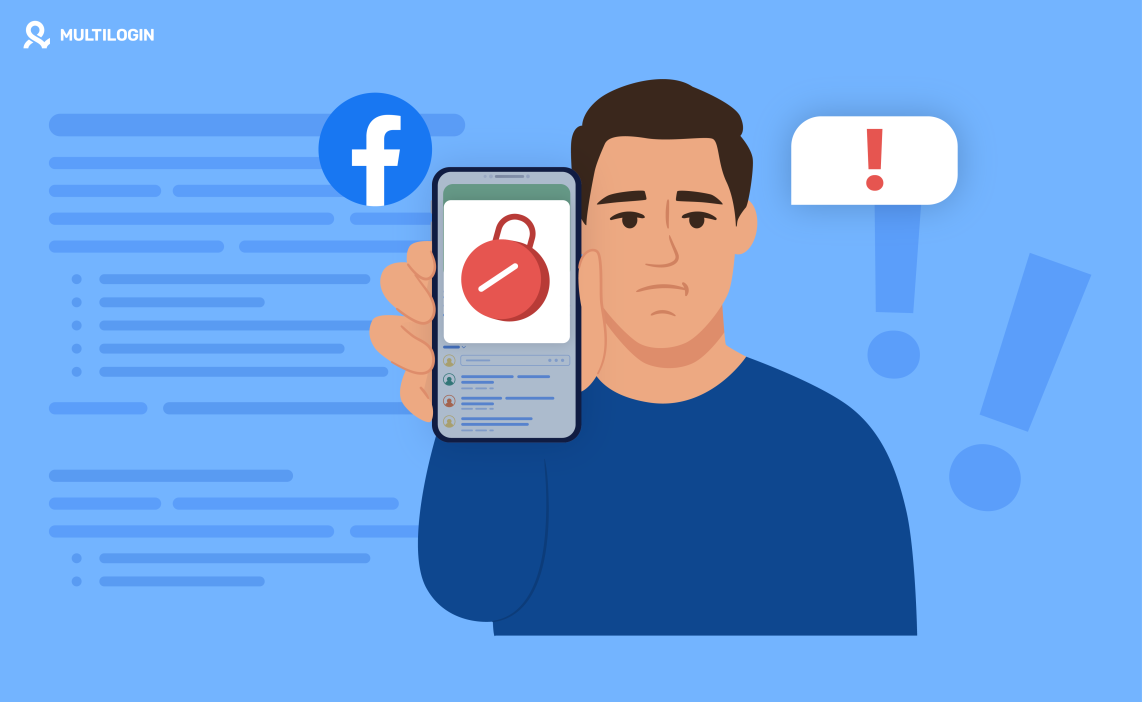Losing access to your Facebook account can be incredibly frustrating, especially if you rely on it for personal connections or business purposes. Facebook’s strict guidelines sometimes lead to accounts being Facebook shadow banned or disabled, and in some cases, it may seem like a challenge to recover your account.
Don’t worry—this guide will walk you through the process of Facebook banned account recovery, ensuring you can regain control of your account as quickly as possible.
Why Was My Facebook Account Disabled or Banned?
Before going into recovery steps, it’s essential to understand why Facebook might ban or disable an account. Reasons include:
Violation of Facebook’s Community Standards: Posting content that violates their rules, such as hate speech, adult content, or misleading information.
Suspicious Activity: If Facebook detects unusual behavior like creating multiple Facebook accounts or engaging in spamming activities.
False Name or Profile Information: If the name on your account doesn’t match Facebook’s guidelines for real names.
Report by Other Users: Multiple reports from other users can trigger a review of your account.
Knowing the reason behind the ban can help you in your recovery appeal.
How to Appeal a Facebook Banned Account
If you believe your account was wrongly banned, Facebook allows you to submit an appeal. Follow these steps:
1. Visit the Facebook Help Center
Head over to the Facebook Help Center and find the disabled account section. This page will explain the reasons why accounts are banned and give you options to start the appeal process.
2. Submit the Facebook Disabled Account Appeal Form
The next step involves filling out the Facebook disabled account appeal form. Make sure you provide accurate and honest details about your account and why you believe it should be restored. Here are some tips:
Be Detailed: Clearly explain why your account should be reinstated, citing any potential misunderstandings.
Avoid Harsh Language: Keep the tone polite and respectful.
Provide Proof of Identity: Attach any requested documents (such as an ID) to verify your identity if asked.
3. Wait for Facebook’s Response
After submitting the appeal form, you will need to wait for Facebook to review your case. It can take anywhere from a few days to a couple of weeks to get a response.
How to Recover a Disabled Facebook Account Without ID
Sometimes, you may be asked to submit an ID during the appeal process, but what if you don’t have one? While recovering a disabled Facebook account without an ID can be challenging, you still have some options:
Use Security Questions: If you have set up security questions, Facebook may use these to verify your identity.
Trusted Contacts: Facebook allows you to designate trusted contacts to help verify your account in the event of a ban.
Email or Phone Verification: If you’ve linked your email address or phone number to your account, you might be able to regain access using a verification code sent to either.
What to Do if Your Account Is Disabled for 180 Days
If your Facebook account has been disabled for a prolonged period, such as 180 days, recovery can become more complicated. After six months, Facebook may consider the account permanently disabled. However, you can still try these methods:
Submit an Appeal Again: After the 180-day period, try submitting another appeal. Sometimes reappealing after a longer period can bring different results.
Reach Out to Facebook Support: Contact Facebook Support directly through email or the help center for assistance with longer-disabled accounts.
Facebook Banned Account Recovery Email
If you prefer to communicate directly, using the Facebook banned account recovery email can be an effective way to appeal. While Facebook’s official support email isn’t always easy to find, reaching out with a concise, polite, and factual email may increase your chances of getting a response.
Email Address: [email protected]
Ensure your email includes:
Full Name: The name on your account.
Account Details: Any relevant information such as the email or phone number linked to the account.
Explanation: A detailed explanation of why you believe your account should be reinstated.
Tips for Preventing Future Bans
If you’ve recovered your account, you’ll want to ensure it doesn’t happen again. Here are some ways to avoid getting banned:
Adhere to Facebook’s Guidelines: Make sure you understand and follow Facebook’s Community Standards to avoid future bans.
Use Strong, Accurate Information: Keep your profile information up to date and ensure it adheres to Facebook’s real-name policy.
Avoid Automated or Suspicious Activity: Don’t use third-party apps that may violate Facebook’s terms of service, and avoid posting spammy content.
What if You Cannot Recover Your Facebook Account? What’s Next?
If you’ve followed all the steps for recovering your Facebook account—from submitting appeals to verifying your identity—and still cannot regain access, it can be incredibly frustrating. Unfortunately, Facebook has strict guidelines and automated systems in place, and sometimes accounts are permanently disabled due to violations or suspicious activity.
So, what should you do next?
1. Accept the Situation (If Recovery is Not Possible)
If your appeal has been rejected and you’ve exhausted all recovery options, it might be time to consider the possibility that your account is permanently disabled. However, don’t worry—there are still ways to move forward:
Start Fresh: You can create a new Facebook account, but to avoid running into the same issues again, it’s important to use best practices for Facebook account management.
Keep Your Information Clean and Accurate: Ensure your account complies with Facebook’s real-name policy and Community Standards to avoid future bans.
2. Reach Out to Facebook Support Again
If you’re convinced that the ban was a mistake or if the account recovery process wasn’t clear, consider contacting Facebook Support once more. In some cases, appealing again after a few weeks or months may lead to a different outcome.
But what if you’re concerned about account security and IP bans happening again in the future? Here’s where Multilogin comes in.
How to Prevent Facebook Account Bans and Protect Your Accounts in the Future
The best way to prevent Facebook account issues is to be proactive in how you manage your accounts. Here’s how Multilogin can help you avoid the common mistakes that lead to bans and ensure your accounts are always safe and secure.
1. Use Multilogin to Manage Multiple Facebook Accounts Safely
Multilogin allows you to create isolated browser profiles for each Facebook account you manage. This means Facebook sees each account as a separate user, preventing account linking and cross-account contamination that often leads to bans.
Facebook’s algorithms flag accounts that show suspicious behavior, like logging into multiple accounts from the same device or IP. By using Multilogin, you ensure that each account has its unique fingerprint, cookies, and proxy, reducing the risk of detection.
2. Avoid Using the Same IP or Device for Multiple Accounts
One of the primary reasons for Facebook account bans is logging into multiple accounts from the same IP address or device. This is an easy way for Facebook to detect suspicious behavior.
With Multilogin, you can assign a unique residential proxy to each browser profile, making each login look like it’s coming from a different real user. This prevents Facebook from flagging your accounts for suspicious activity.
3. Mask Your Digital Fingerprint
Facebook uses browser fingerprinting to track your activity across devices. If your device fingerprint (like your screen resolution, fonts, and plugins) doesn’t match the usual profile, Facebook may flag your account as suspicious.
Multilogin uses advanced antidetect technology to mask your browser fingerprint, ensuring that your activity appears natural to Facebook. By making each session look like it’s coming from a real user, you can avoid detection.
4. Keep Your Accounts Organized and Secure
Managing multiple accounts can quickly become overwhelming, especially if you’re running campaigns or handling client accounts. Multilogin allows you to manage all your accounts from one central dashboard, keeping them organized and secure.
Multilogin’s user-friendly interface makes it easy to switch between accounts without risking confusion or accidentally logging into the wrong account.
5. Use Multilogin for Automated Account Management
Multilogin allows you to automate tasks like profile creation, proxy assignment, and ad testing. This reduces the risk of human error and helps you scale your Facebook activities without running into issues.
With automation built directly into Multilogin, you can maintain consistent behavior across accounts and ensure you follow best practices for Facebook account management.
How to Get Started with Multilogin to Protect Your Facebook Accounts
Now that you understand how Multilogin can help you prevent bans and securely manage multiple Facebook accounts, here’s how to get started:
Step 1: Start Your 3-Day Trial for Just €1.99
Get a low-risk trial for just €1.99. This includes 5 browser profiles and residential proxy traffic so you can test how Multilogin works to help you securely manage multiple Facebook accounts.
Action: Sign up today and start exploring the features that will help you keep your accounts safe.
Step 2: Create Isolated Profiles for Each Facebook Account
Use Multilogin to create a separate browser profile for each Facebook account, ensuring that your activities remain isolated.
Action: Set up your profiles to make sure each Facebook account is completely isolated from others, reducing the risk of Facebook linking them together.
Step 3: Assign Residential Proxies to Each Profile
To ensure Facebook doesn’t flag your accounts, assign a unique residential proxy to each profile. This makes your logins appear like they’re coming from real users.
Action: Use Multilogin’s integrated residential proxies to assign a unique IP to each Facebook profile.
Step 4: Start Managing Your Accounts
Once your accounts are set up, you can easily manage and scale them without worrying about bans or restrictions.
Action: Launch your campaigns or manage multiple Facebook accounts securely with Multilogin, knowing that your accounts are isolated, secure, and undetectable.
Manage multiple Facebook accounts without bans using Multilogin
Frequently Asked Questions About Facebook Banned Account Recovery
The recovery process can take anywhere from a few days to a few weeks. Facebook’s response time varies depending on the reason for the ban and the complexity of the appeal.
Yes, if you can’t provide an ID, Facebook may allow you to verify your account using your email, phone number, or trusted contacts.
Yes, Facebook provides an option to appeal the ban through their Help Center.
Facebook bans accounts due to suspicious activity—such as multiple logins from the same IP address, inconsistent device metadata, automation abuse, or policy violations. Browser fingerprinting plays a key role in identifying linked or suspicious accounts.
You can contact Facebook Support directly via the Help Center or email at [email protected].
If your appeal is rejected, there may be no further options for recovery, especially if Facebook considers the account permanently disabled.
While recovery becomes more difficult after 180 days, submitting another appeal or reaching out to Facebook support can still work in some cases.
How Multilogin Helps You Avoid Facebook Account Issues
While Multilogin won’t directly help with recovering a banned Facebook account, it’s the best tool to prevent bans and manage multiple accounts securely.
By providing features like profile isolation, fingerprint masking, residential proxies, and account management automation, Multilogin helps you keep your Facebook accounts safe and undetected.
With Multilogin, you’ll be able to scale your Facebook ad campaigns, manage multiple accounts without worrying about detection, and avoid the frustrations that come with account bans.



